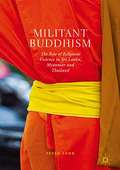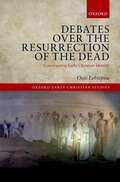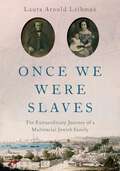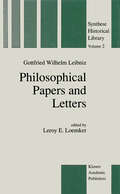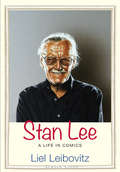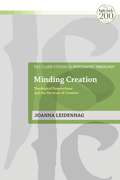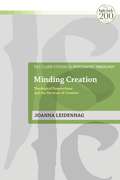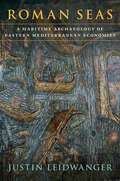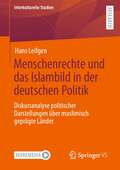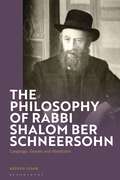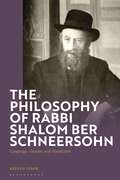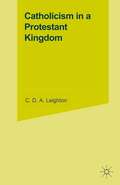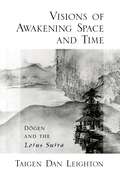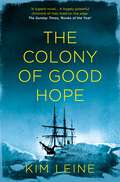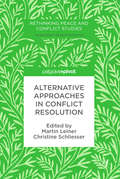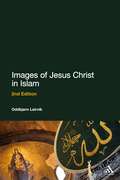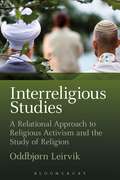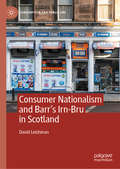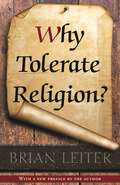- Table View
- List View
Militant Buddhism: The Rise of Religious Violence in Sri Lanka, Myanmar and Thailand
by Peter LehrAgainst the backdrop of the ongoing Rohingya crisis, this book takes a close and detailed look at the rise of militant Buddhism in Sri Lanka, Burma and Thailand, and especially at the issues of ‘why’ and ‘how’ around it. We are well aware of Christian fundamentalism, militant Judaism and Islamist Salafism-Jihadism. Extremist and violent Buddhism however features only rarely in book-length studies on religion and political violence. Somehow, the very idea of Buddhist monks as the archetypical ‘world renouncers’ exhorting frenzied mobs to commit acts of violence against perceived ‘enemies of the religion’ seems to be outright ludicrous. Recent events in Myanmar/Burma, but also in Thailand and Sri Lanka, however indicate that a militant strand of Theravada Buddhism is on the rise. How can this rise be explained, and what role do monks play in that regard? These are the two broad questions that this book explores.
Debates over the Resurrection of the Dead: Constructing Early Christian Identity (Oxford Early Christian Studies)
by Outi LehtipuuIn Debates over the Resurrection of the Dead, Outi Lehtipuu highlights the striking observation that in many early texts the way that belief in resurrection is formulated is used as a sign of inclusion and exclusion, not only in relation to non-Christians but vis-à-vis other Christians. Those who teach otherwise have deviated from the truth, are not true Christians, and do the works of the devil. Using insights from the sociological study of deviance, Dr Lehtipuu demonstrates that labelling was used as a tool for marking boundaries between those who belonged and those who did not. This was extremely important in the fluid conditions where the small Christian minority groups found themselves. In a situation where there were no universally accepted structures that defined what constituted the true Christian belief, several competing interpretations and their representatives struggled for recognition of their views based on what they believed to be the apostolic tradition. The most hotly-debated aspect of resurrection was whether it would entail the body of flesh and blood or not. When resurrection would take place was closely related to this. Controversies died since the scriptural legacy was ambiguous enough to allow different hermeneutical solutions. The battle over resurrection was closely related to the question of how scriptures were to be understood as well as to what constituted the human self that would survive death. To demonstrate this a wide variety of texts are studied, from theological treatises (including relevant Nag Hammadi texts) to apocryphal acts and martyrologies. Acknowledging the complexity and diversity of the early Christian movement, this volume views early Christian discourse as part of the broader ancient discursive world where similar debates were going on among both Jews and the majority population.
Once We Were Slaves: The Extraordinary Journey of a Multi-Racial Jewish Family
by Laura Arnold LeibmanAn obsessive genealogist and descendent of one of the most prominent Jewish families since the American Revolution, Blanche Moses firmly believed her maternal ancestors were Sephardic grandees. Yet she found herself at a dead end when it came to her grandmother's maternal line. Using family heirlooms to unlock the mystery of Moses's ancestors, Once We Were Slaves overturns the reclusive heiress's assumptions about her family history to reveal that her grandmother and great-uncle, Sarah and Isaac Brandon, actually began their lives as poor Christian slaves in Barbados. Tracing the siblings' extraordinary journey throughout the Atlantic World, Leibman examines artifacts they left behind in Barbados, Suriname, London, Philadelphia, and, finally, New York, to show how Sarah and Isaac were able to transform themselves and their lives, becoming free, wealthy, Jewish, and--at times--white. While their affluence made them unusual, their story mirrors that of the largely forgotten population of mixed African and Jewish ancestry that constituted as much as ten percent of the Jewish communities in which the siblings lived, and sheds new light on the fluidity of race--as well as on the role of religion in racial shift--in the first half of the nineteenth century.
Once We Were Slaves: The Extraordinary Journey of a Multi-Racial Jewish Family
by Laura Arnold LeibmanAn obsessive genealogist and descendent of one of the most prominent Jewish families since the American Revolution, Blanche Moses firmly believed her maternal ancestors were Sephardic grandees. Yet she found herself at a dead end when it came to her grandmother's maternal line. Using family heirlooms to unlock the mystery of Moses's ancestors, Once We Were Slaves overturns the reclusive heiress's assumptions about her family history to reveal that her grandmother and great-uncle, Sarah and Isaac Brandon, actually began their lives as poor Christian slaves in Barbados. Tracing the siblings' extraordinary journey throughout the Atlantic World, Leibman examines artifacts they left behind in Barbados, Suriname, London, Philadelphia, and, finally, New York, to show how Sarah and Isaac were able to transform themselves and their lives, becoming free, wealthy, Jewish, and--at times--white. While their affluence made them unusual, their story mirrors that of the largely forgotten population of mixed African and Jewish ancestry that constituted as much as ten percent of the Jewish communities in which the siblings lived, and sheds new light on the fluidity of race--as well as on the role of religion in racial shift--in the first half of the nineteenth century.
Philosophical Papers and Letters: A Selection (Synthese Historical Library #2)
by G.W. LeibnizThe selections contained in these volumes from the papers and letters of Leibniz are intended to serve the student in two ways: first, by providing a more adequate and balanced conception of the full range and penetration of Leibniz's creative intellectual powers; second, by inviting a fresher approach to his intellectual growth and a clearer perception of the internal strains in his thinking, through a chronological arrangement. Much confusion has arisen in the past through a neglect of the develop ment of Leibniz's ideas, and Couturat's impressive plea, in his edition of the Opuscu/es et fragments (p. xii), for such an arrangement is valid even for incomplete editions. The beginning student will do well, however, to read the maturer writings of Parts II, III, and IV first, leaving Part I, from a period too largely neglected by Leibniz criticism, for a later study of the still obscure sources and motives of his thought. The Introduction aims primarily to provide cultural orientation and an exposition of the structure and the underlying assumptions of the philosophical system rather than a critical evaluation. I hope that together with the notes and the Index, it will provide those aids to the understanding which the originality of Leibniz's scientific, ethical, and metaphysical efforts deserve.
Stan Lee: A Life in Comics (Jewish Lives)
by Liel LeibovitzFrom the prizewinning Jewish Lives series, a meditation on the deeply Jewish and surprisingly spiritual roots of Stan Lee and Marvel Comics Few artists have had as much of an impact on American popular culture as Stan Lee. The characters he created—Spider-Man and Iron Man, the X-Men and the Fantastic Four—occupy Hollywood’s imagination and production schedules, generate billions at the box office, and come as close as anything we have to a shared American mythology. This illuminating biography focuses as much on Lee’s ideas as it does on his unlikely rise to stardom. It surveys his cultural and religious upbringing and draws surprising connections between celebrated comic book heroes and the ancient tales of the Bible, the Talmud, and Jewish mysticism. Was Spider-Man just a reincarnation of Cain? Is the Incredible Hulk simply Adam by another name? From close readings of Lee’s work to little-known anecdotes from Marvel’s history, the book paints a portrait of Lee that goes much deeper than one of his signature onscreen cameos.About Jewish Lives: Jewish Lives is a prizewinning series of interpretative biography designed to explore the many facets of Jewish identity. Individual volumes illuminate the imprint of Jewish figures upon literature, religion, philosophy, politics, cultural and economic life, and the arts and sciences. Subjects are paired with authors to elicit lively, deeply informed books that explore the range and depth of the Jewish experience from antiquity to the present. In 2014, the Jewish Book Council named Jewish Lives the winner of its Jewish Book of the Year Award, the first series ever to receive this award.More praise for Jewish Lives: "Excellent." – New York times "Exemplary." – Wall St. Journal "Distinguished." – New Yorker "Superb." – The Guardian
Minding Creation: Theological Panpsychism And The Doctrine Of Creation (T&T Clark Studies in Systematic Theology)
by Joanna LeidenhagAre humans the only creatures that can appreciate God's creation? What if consciousness is spread more widely across all things? This volume examines panpsychism through the lens of Christian doctrine. Minding Creation is the first substantial examination of what a panpsychist theory of consciousness implies for key theological debates concerning God's presence and action, evolution and the origin of the soul, human uniqueness and the environmental crisis.Joanna Leidenhag develops a theological panpsychism that is based on an exceptionally wide range of scholarship. Minding Creation draws on the theologies of historical figures such as Augustine of Hippo, Gottfried von Leibniz and others, in order to create a critical and constructive conversation with contemporary analytic philosophers of mind, such as Thomas Nagel, Galen Strawson, and David J. Chalmers. Leidenhag also discusses key concepts and issues, such as emergence theory, divine action, and ecology. She concludes that God created a universe from nothing which is filled with indwelling powers, sacramental value, and intrinsic experience. This is a creation in which the Holy Spirit is internally present at every point, a creation that worships God, and a creation that human beings must protect and lead in praise.
Minding Creation: Theological Panpsychism and the Doctrine of Creation (T&T Clark Studies in Systematic Theology)
by Joanna LeidenhagAre humans the only creatures that can appreciate God's creation? What if consciousness is spread more widely across all things? This volume examines panpsychism through the lens of Christian doctrine. Minding Creation is the first substantial examination of what a panpsychist theory of consciousness implies for key theological debates concerning God's presence and action, evolution and the origin of the soul, human uniqueness and the environmental crisis.Joanna Leidenhag develops a theological panpsychism that is based on an exceptionally wide range of scholarship. Minding Creation draws on the theologies of historical figures such as Augustine of Hippo, Gottfried von Leibniz and others, in order to create a critical and constructive conversation with contemporary analytic philosophers of mind, such as Thomas Nagel, Galen Strawson, and David J. Chalmers. Leidenhag also discusses key concepts and issues, such as emergence theory, divine action, and ecology. She concludes that God created a universe from nothing which is filled with indwelling powers, sacramental value, and intrinsic experience. This is a creation in which the Holy Spirit is internally present at every point, a creation that worships God, and a creation that human beings must protect and lead in praise.
Roman Seas: A Maritime Archaeology of Eastern Mediterranean Economies
by Justin LeidwangerThat seafaring was fundamental to Roman prosperity in the eastern Mediterranean is beyond doubt, but a tendency by scholars to focus on the grandest long-distance movements between major cities has obscured the finer and varied contours of maritime interaction. This book offers a nuanced archaeological analysis of maritime economy and connectivity in the Roman east. Drawing together maritime landscape studies and network analysis, Roman Seas takes a bottom-up view of the diverse socioeconomic conditions and seafaring logistics that generated multiple structures and scales of interaction. The material record of shipwrecks and ports along a vital corridor from the southeast Aegean across the northeast Mediterranean provides a case study of regional exchange and communication based on routine sails between simple coastal harbors. Rather than a single well-integrated and persistent Mediterranean network, multiple discrete and evolving regional and interregional systems emerge. This analysis sheds light on the cadence of economic life along the coast, the development of market institutions, and the regional continuities that underpinned integration-despite imperial fragmentation-between the second century BCE and the seventh century CE. Roman Seas advances a new approach to the synthesis of shipwreck and other maritime archaeological and historical economic data, as well as a path through the stark dichotomies-either big commercial voyages or small-scale cabotage-that inform most paradigms of Roman connectivity and trade. The result is a unique perspective on ancient Mediterranean trade, seafaring, cultural interaction, and coastal life.
Roman Seas: A Maritime Archaeology of Eastern Mediterranean Economies
by Justin LeidwangerThat seafaring was fundamental to Roman prosperity in the eastern Mediterranean is beyond doubt, but a tendency by scholars to focus on the grandest long-distance movements between major cities has obscured the finer and varied contours of maritime interaction. This book offers a nuanced archaeological analysis of maritime economy and connectivity in the Roman east. Drawing together maritime landscape studies and network analysis, Roman Seas takes a bottom-up view of the diverse socioeconomic conditions and seafaring logistics that generated multiple structures and scales of interaction. The material record of shipwrecks and ports along a vital corridor from the southeast Aegean across the northeast Mediterranean provides a case study of regional exchange and communication based on routine sails between simple coastal harbors. Rather than a single well-integrated and persistent Mediterranean network, multiple discrete and evolving regional and interregional systems emerge. This analysis sheds light on the cadence of economic life along the coast, the development of market institutions, and the regional continuities that underpinned integration-despite imperial fragmentation-between the second century BCE and the seventh century CE. Roman Seas advances a new approach to the synthesis of shipwreck and other maritime archaeological and historical economic data, as well as a path through the stark dichotomies-either big commercial voyages or small-scale cabotage-that inform most paradigms of Roman connectivity and trade. The result is a unique perspective on ancient Mediterranean trade, seafaring, cultural interaction, and coastal life.
Menschenrechte und das Islambild in der deutschen Politik: Diskursanalyse politischer Darstellungen über muslimisch geprägte Länder (Interkulturelle Studien)
by Hans LeifgenPolitische Berichte und menschenrechtliche Debatten prägen das Islambild in Deutschland mit. Die vorliegende Forschungsarbeit setzt sich exemplarisch mit der Menschenrechtsberichterstattung der politischen Fraktionen im Deutschen Bundestag über muslimisch geprägte Länder auseinander. Im Zentrum des Interesses stehen dabei die Fragen, wie die Menschenrechtslage in muslimisch geprägten Ländern dargestellt und welcher menschenrechtliche Bezugsrahmen verwendet wird sowie, welche Rolle die Religion Islam bei der Berichterstattung spielt. Hierzu werden die diskurstheoretische Perspektive Foucaults (1981) und der forschungsmethodische Zugang der Kritischen Diskursanalyse Jägers (2015) herangezogen. Ziel der Forschung ist, exemplarische Erkenntnisse über potenzielle gesamtgesellschaftliche Auswirkungen der Berichterstattung – insbesondere auf das Islambild in Deutschland – zu erhalten. Daher untersucht die Arbeit, wie bei der Berichterstattung Wirklichkeit konstruiert wird.
The Philosophy of Rabbi Shalom Ber Schneersohn: Language, Gender and Mysticism
by Rabbi Dr Reuven LeighReuven Leigh provides the first in-depth introduction to the pioneering philosophy of Rabbi Shalom Ber Schneersohn. Bringing him into dialogue with key continental philosophers Emmanuel Levinas, Jacques Derrida and Julia Kristeva, this book reveals how Schneersohn's views anticipated many prominent themes in 20th-century thought. Shalom Ber Schneersohn (1860-1920) was the fifth Rebbe of the Habad-Lubavitch dynasty. He was a traditional, kabbalistic thinker and yet, beyond mysticism, he wrote extensively on speech, gender and the body. So why is he not better known? Leigh begins by uncovering and contesting numerous scholarly assumptions that have operated to exclude traditional rabbinic thinkers from contemporary philosophical debates. Seeking to correct this, this book offers a close reading of Schneersohn's 1898 discourses. With the disruption of traditional binary structures being the dominant theme pervading Schneersohn's work, Leigh engages with Levinas' provocative ideas on speech and the feminine. He also highlights how Derridean deconstruction involves a more positive approach to presence that was already anticipated in the writings of Schneersohn. And from the disruption of the hierarchy of signification to the semiotic aspect of language and the maternal body, this book demonstrates how Schneersohn foreshadows a number of Kristeva's central philosophical concerns. A wide-ranging and inclusive volume, The Philosophy of Rabbi Shalom Ber Schneersohn demonstrates not only how forward-thinking Schneersohn's ideas were over a century ago, but how relevant they still are today.
The Philosophy of Rabbi Shalom Ber Schneersohn: Language, Gender and Mysticism
by Rabbi Dr Reuven LeighReuven Leigh provides the first in-depth introduction to the pioneering philosophy of Rabbi Shalom Ber Schneersohn. Bringing him into dialogue with key continental philosophers Emmanuel Levinas, Jacques Derrida and Julia Kristeva, this book reveals how Schneersohn's views anticipated many prominent themes in 20th-century thought. Shalom Ber Schneersohn (1860-1920) was the fifth Rebbe of the Habad-Lubavitch dynasty. He was a traditional, kabbalistic thinker and yet, beyond mysticism, he wrote extensively on speech, gender and the body. So why is he not better known? Leigh begins by uncovering and contesting numerous scholarly assumptions that have operated to exclude traditional rabbinic thinkers from contemporary philosophical debates. Seeking to correct this, this book offers a close reading of Schneersohn's 1898 discourses. With the disruption of traditional binary structures being the dominant theme pervading Schneersohn's work, Leigh engages with Levinas' provocative ideas on speech and the feminine. He also highlights how Derridean deconstruction involves a more positive approach to presence that was already anticipated in the writings of Schneersohn. And from the disruption of the hierarchy of signification to the semiotic aspect of language and the maternal body, this book demonstrates how Schneersohn foreshadows a number of Kristeva's central philosophical concerns. A wide-ranging and inclusive volume, The Philosophy of Rabbi Shalom Ber Schneersohn demonstrates not only how forward-thinking Schneersohn's ideas were over a century ago, but how relevant they still are today.
Catholicism in a Protestant Kingdom: A Study of the Irish Ancien Régime (Studies in Modern History)
by C.D.A. LeightonEscaping from narrative history, this book takes a deep look at the Catholic question in eighteenth-century Ireland. It asks how people thought about Catholicism, Protestantism and their society, in order to reassess the content and importance of the religious conflict. In doing this, Dr Cadoc Leighton provides a study of very wide appeal, which offers new and thought-provoking ways of looking not only at the eighteenth century but at modern Irish history in general. It also places Ireland clearly within the mainstream of European historical developments.
Visions of Awakening Space and Time: Dōgen and the Lotus Sutra
by Taigen Dan LeightonAs a religion concerned with universal liberation, Zen grew out of a Buddhist worldview very different from the currently prevalent scientific materialism. Indeed, says Taigen Dan Leighton, Zen cannot be fully understood outside of a worldview that sees reality itself as a vital, dynamic agent of awareness and healing. In this book, Leighton explicates that worldview through the writings of the Zen master Eihei Dōgen (1200-1253), considered the founder of the Japanese Sōtō Zen tradition, which currently enjoys increasing popularity in the West. The Lotus Sutra, arguably the most important Buddhist scripture in East Asia, contains a famous story about bodhisattvas (enlightening beings) who emerge from under the earth to preserve and expound the Lotus teaching in the distant future. The story reveals that the Buddha only appears to pass away, but actually has been practicing, and will continue to do so, over an inconceivably long life span. Leighton traces commentaries on the Lotus Sutra from a range of key East Asian Buddhist thinkers, including Daosheng, Zhiyi, Zhanran, Saigyo, Myōe, Nichiren, Hakuin, and Ryōkan. But his main focus is Eihei Dōgen, the 13th century Japanese Sōtō Zen founder who imported Zen from China, and whose profuse, provocative, and poetic writings are important to the modern expansion of Buddhism to the West. Dōgen's use of this sutra expresses the critical role of Mahayana vision and imagination as the context of Zen teaching, and his interpretations of this story furthermore reveal his dynamic worldview of the earth, space, and time themselves as vital agents of spiritual awakening. Leighton argues that Dōgen uses the images and metaphors in this story to express his own religious worldview, in which earth, space, and time are lively agents in the bodhisattva project. Broader awareness of Dōgen's worldview and its implications, says Leighton, can illuminate the possibilities for contemporary approaches to primary Mahayana concepts and practices.
Visions of Awakening Space and Time: Dōgen and the Lotus Sutra
by Taigen Dan LeightonAs a religion concerned with universal liberation, Zen grew out of a Buddhist worldview very different from the currently prevalent scientific materialism. Indeed, says Taigen Dan Leighton, Zen cannot be fully understood outside of a worldview that sees reality itself as a vital, dynamic agent of awareness and healing. In this book, Leighton explicates that worldview through the writings of the Zen master Eihei Dōgen (1200-1253), considered the founder of the Japanese Sōtō Zen tradition, which currently enjoys increasing popularity in the West. The Lotus Sutra, arguably the most important Buddhist scripture in East Asia, contains a famous story about bodhisattvas (enlightening beings) who emerge from under the earth to preserve and expound the Lotus teaching in the distant future. The story reveals that the Buddha only appears to pass away, but actually has been practicing, and will continue to do so, over an inconceivably long life span. Leighton traces commentaries on the Lotus Sutra from a range of key East Asian Buddhist thinkers, including Daosheng, Zhiyi, Zhanran, Saigyo, Myōe, Nichiren, Hakuin, and Ryōkan. But his main focus is Eihei Dōgen, the 13th century Japanese Sōtō Zen founder who imported Zen from China, and whose profuse, provocative, and poetic writings are important to the modern expansion of Buddhism to the West. Dōgen's use of this sutra expresses the critical role of Mahayana vision and imagination as the context of Zen teaching, and his interpretations of this story furthermore reveal his dynamic worldview of the earth, space, and time themselves as vital agents of spiritual awakening. Leighton argues that Dōgen uses the images and metaphors in this story to express his own religious worldview, in which earth, space, and time are lively agents in the bodhisattva project. Broader awareness of Dōgen's worldview and its implications, says Leighton, can illuminate the possibilities for contemporary approaches to primary Mahayana concepts and practices.
The Colony of Good Hope
by Kim LeineIn the tradition of Conrad’s Heart of Darkness, an immensely powerful historical novel about the first encounters between Danish colonists and Greenlanders in the early eighteenth century, of brutal clashes between priests and pagans and the forces that drive each individual towards darkness or light.1728: The Danish King Fredrik IV sends a governor to Greenland to establish a colony, in the hopes of exploiting the country’s allegedly vast natural resources. A few merchants, a barber-surgeon, two trainee priests, a blacksmith, some carpenters and soldiers and a dozen hastily married couples go with him.The missionary priest Hans Egede has already been in Greenland for several years when the new colonists arrive. He has established a mission there, but the converts are few. Among those most hostile to Egede is the shaman Aappaluttoq, whose own son was taken by the priest and raised in the Christian faith as his own. Thus the great rift between two men, and two ways of life, is born.The newly arrived couples – men and women plucked from prison – quickly sink into a life of almost complete dissolution, and soon unsanitary conditions, illness and death bring the colony to its knees. Through the starvation and the epidemics that beset the colony, Egede remains steadfast in his determination – willing to sacrifice even those he loves for the sake of his mission.In The Colony of Good Hope, Kim Leine explores what happens when two cultures confront one another. In a distant colony, under the harshest conditions, the overwhelming forces of nature meet the vices of man.
Alternative Approaches in Conflict Resolution (PDF)
by Martin Leiner Christine SchliesserThis edited volume brings together alternative and innovative approaches in conflict resolution. With traditional military intervention repeatedly leading to the transformation of entire regions into zones of instability and violence (Afghanistan, Iraq, Libya, Syria), the study of alternative and less violent approaches to conflict resolution has become imperative. Four approaches are presented here: negotiation, religion and gender, reconciliation and forgiveness, and the arts. This volume contains the insights and experiences of fourteen internationally renowned scholars and practitioners from different contexts. Can forgiveness help heal relationships in post-apartheid South Africa? How can art assist dealing with ‘unrememberable’ events such as the genocide in Rwanda? What transformational resources do women offer in contexts of massive human rights violations? The aim here is twofold: to provide and encourage critical reflection of the approaches presented here and to explore concrete improvements in conflict resolution strategies. In its interdisciplinary and international outlook, this work combines the tried-and-tested approaches from conflict resolution experts in academia, NGOs and civil society, making it an invaluable tool for academics and practitioners alike.
Images of Jesus Christ in Islam: 2nd Edition
by Oddbjørn LeirvikImages of Jesus Christ in Islam 2nd Edition provides a general introduction to the question of Jesus Christ in Islam and a dialogical discussion of this issues' importance for Christian-Muslim relations. Its originality lies in its comprehensive presentation of relevant sources and research and its discussion of Islamic images of Christ in the wider context of Muslim-Christian relations. Oddbjørn Leirvik provides a comprehensive introduction to a breadth of Muslim traditions through an examination of interpretations of Jesus throughout history, whilst also examining historic tensions between Islam and Christianity. This book's distinctive contribution lies in its dialogical perspective in the perennial area of interest of Islam and Christian-Muslim relations.
Images of Jesus Christ in Islam: 2nd Edition
by Oddbjørn LeirvikImages of Jesus Christ in Islam 2nd Edition provides a general introduction to the question of Jesus Christ in Islam and a dialogical discussion of this issues' importance for Christian-Muslim relations. Its originality lies in its comprehensive presentation of relevant sources and research and its discussion of Islamic images of Christ in the wider context of Muslim-Christian relations. Oddbjørn Leirvik provides a comprehensive introduction to a breadth of Muslim traditions through an examination of interpretations of Jesus throughout history, whilst also examining historic tensions between Islam and Christianity. This book's distinctive contribution lies in its dialogical perspective in the perennial area of interest of Islam and Christian-Muslim relations.
Interreligious Studies: A Relational Approach to Religious Activism and the Study of Religion
by Oddbjørn LeirvikThe notion of Interreligious Studies signals a new academic perspective on the study of religion, characterized by a relational approach. Interreligious Studies defines the essential features of interreligious studies compared with alternative conceptions of religious studies and theology. The book discusses pressing and salient challenges in interreligious relations, including interreligious dialogue in practice and theory, interfaith dialogue and secularity, confrontational identity politics, faith-based diplomacy, the question of interfaith learning in school, and interreligious responses to extremism. Interreligious Studies is a cutting-edge study from one of the most important voices in Europe in the field, Oddbjørn Leirvik, and includes case study material from his native Norway including interreligious responses to the bomb attack in Norway on 22nd July 2011, as well as examples from a number of other national and global contexts Expanding discussions on interreligious dialogue and the relationship between religions in new and interesting ways, this book is a much-needed addition to the growing literature on interreligious studies.
Interreligious Studies: A Relational Approach to Religious Activism and the Study of Religion
by Oddbjørn LeirvikThe notion of Interreligious Studies signals a new academic perspective on the study of religion, characterized by a relational approach. Interreligious Studies defines the essential features of interreligious studies compared with alternative conceptions of religious studies and theology. The book discusses pressing and salient challenges in interreligious relations, including interreligious dialogue in practice and theory, interfaith dialogue and secularity, confrontational identity politics, faith-based diplomacy, the question of interfaith learning in school, and interreligious responses to extremism. Interreligious Studies is a cutting-edge study from one of the most important voices in Europe in the field, Oddbjørn Leirvik, and includes case study material from his native Norway including interreligious responses to the bomb attack in Norway on 22nd July 2011, as well as examples from a number of other national and global contexts Expanding discussions on interreligious dialogue and the relationship between religions in new and interesting ways, this book is a much-needed addition to the growing literature on interreligious studies.
Consumer Nationalism and Barr’s Irn-Bru in Scotland: Iron Nation (Consumption and Public Life)
by David LeishmanThis book connects a detailed analysis of Irn-Bru’s brand identity over time to theories of national identity, consumer studies, and banal nationalism. It situates the commercial history of Barr’s Irn-Bru in a transnational context and shows how Irn-Bru has become a symbol of Scotland through processes of rewriting, reframing and institutionalized forgetting, linking the consumption of what began as a trans-national generic product to a specific national community. As such, Leishman presents a longitudinal, cross-disciplinary approach to analysing branding and advertising as multi-modal forms of discourse, in order to underline the role of commercial, non-state actors and popular consumerism in the phenomenon of banal nationalism. It will be of interest to students and scholars researching nationalism, consumption, and Scottish studies.
Why Tolerate Religion?
by Brian LeiterThis provocative book addresses one of the most enduring puzzles in political philosophy and constitutional theory—why is religion singled out for preferential treatment in both law and public discourse? Why are religious obligations that conflict with the law accorded special toleration while other obligations of conscience are not? In Why Tolerate Religion?, Brian Leiter shows why our reasons for tolerating religion are not specific to religion but apply to all claims of conscience, and why a government committed to liberty of conscience is not required by the principle of toleration to grant exemptions to laws that promote the general welfare.
Why Tolerate Religion?
by Brian LeiterThis provocative book addresses one of the most enduring puzzles in political philosophy and constitutional theory—why is religion singled out for preferential treatment in both law and public discourse? Why are religious obligations that conflict with the law accorded special toleration while other obligations of conscience are not? In Why Tolerate Religion?, Brian Leiter shows why our reasons for tolerating religion are not specific to religion but apply to all claims of conscience, and why a government committed to liberty of conscience is not required by the principle of toleration to grant exemptions to laws that promote the general welfare.
